
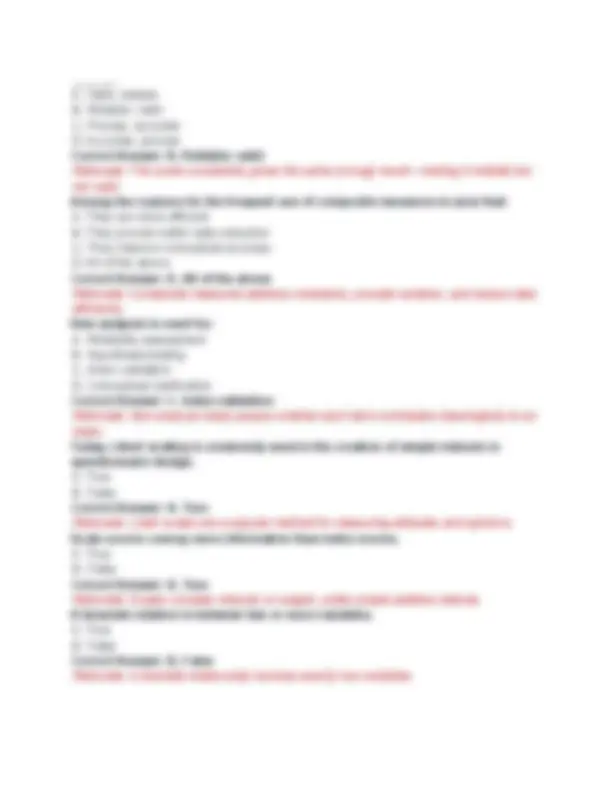
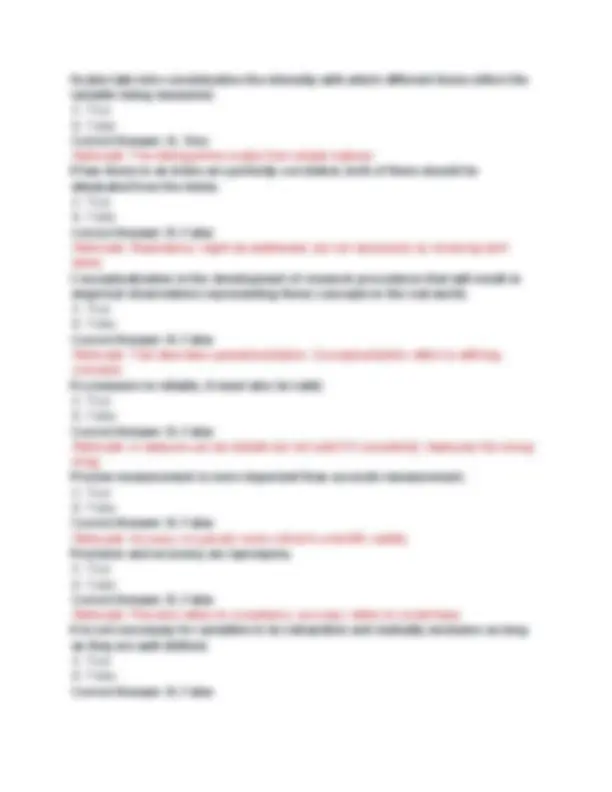
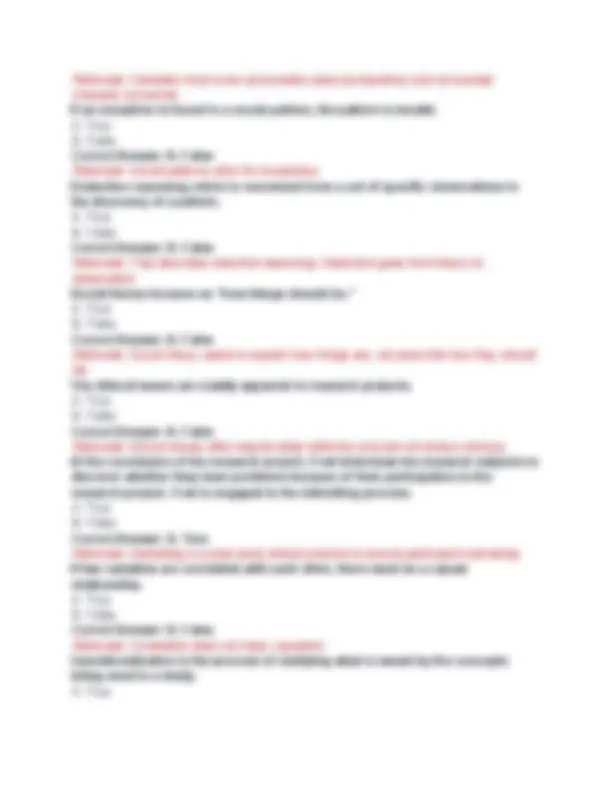
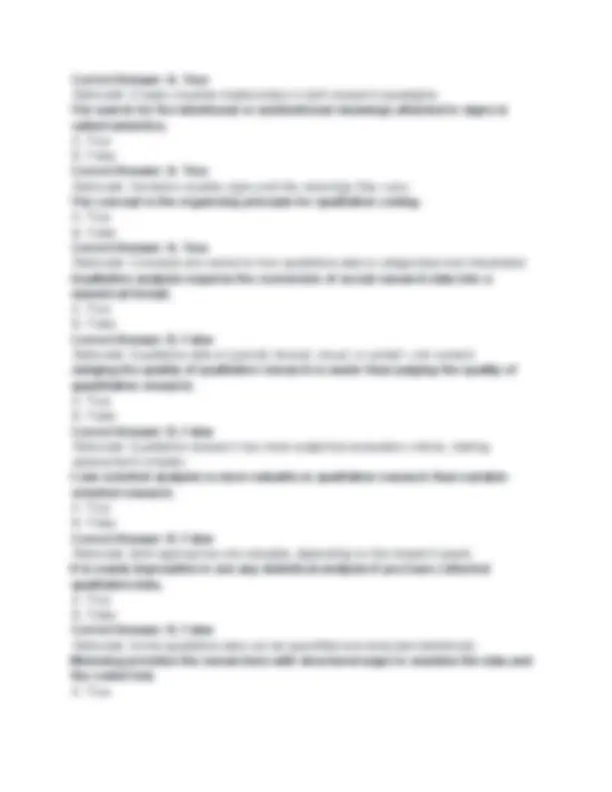
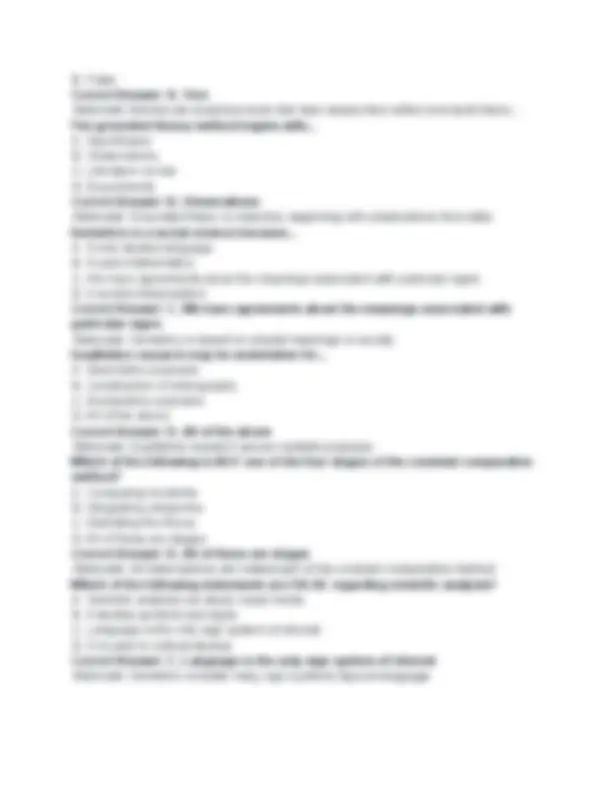
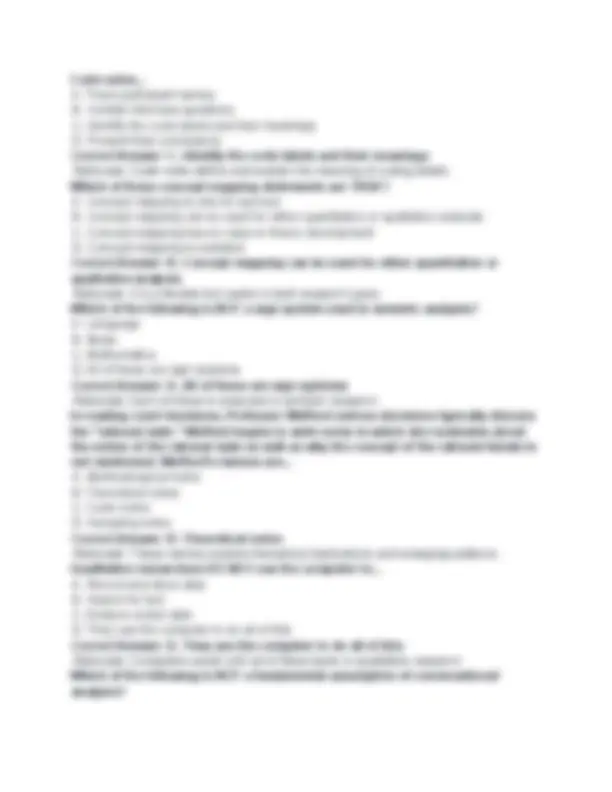
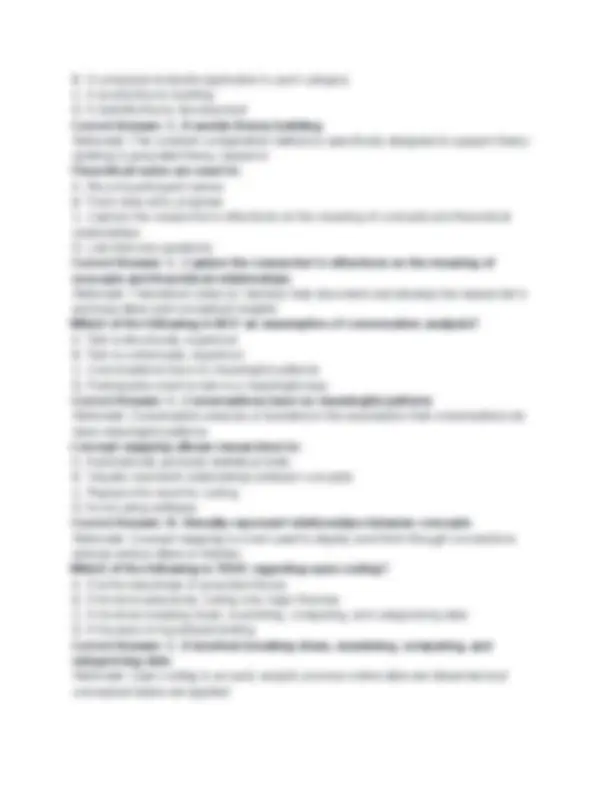
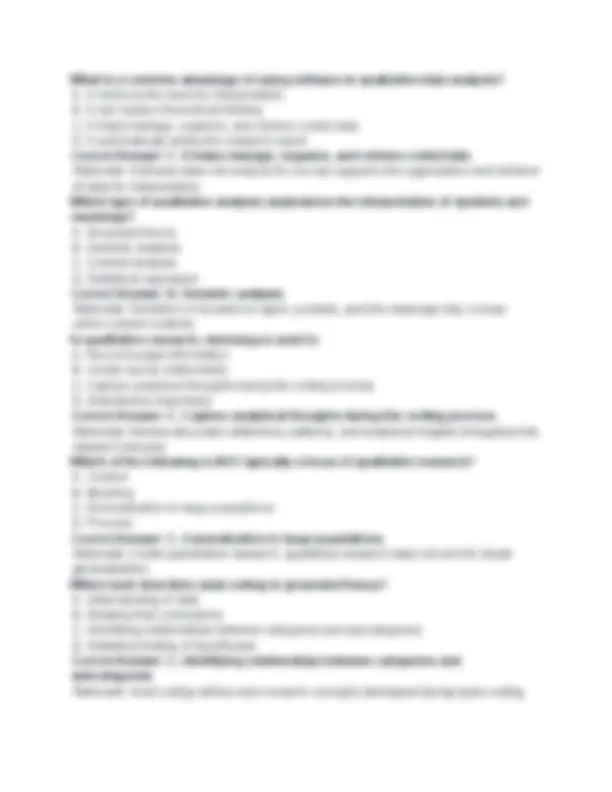
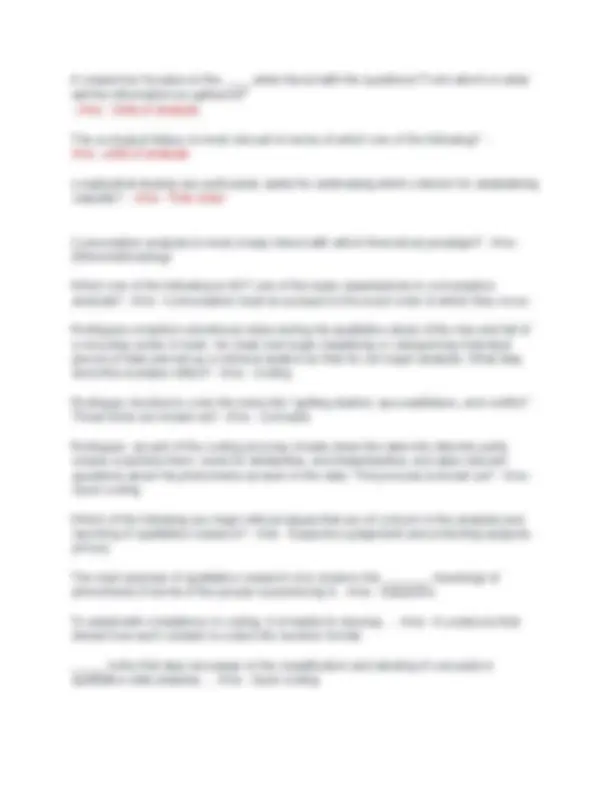
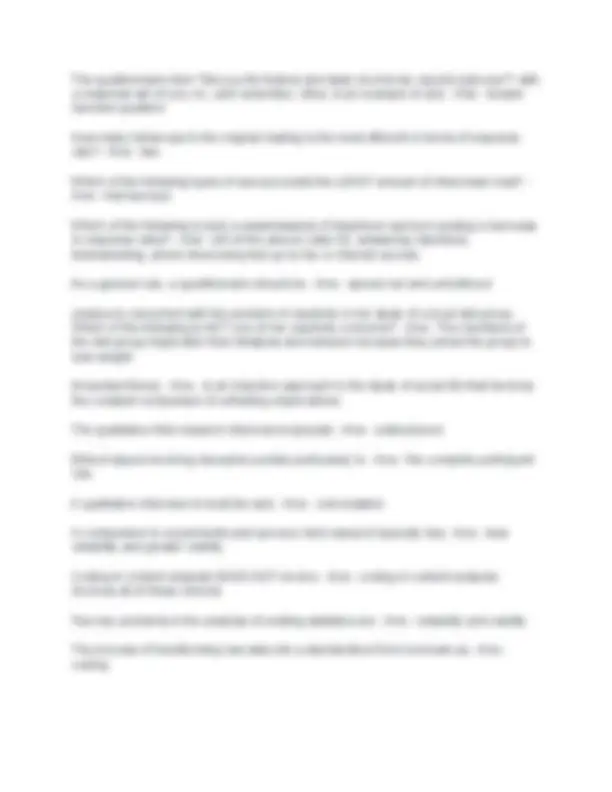


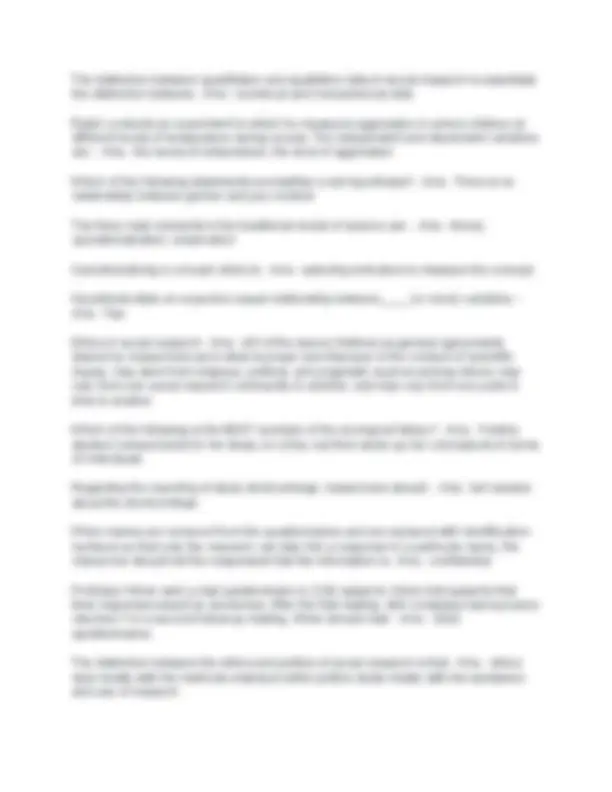
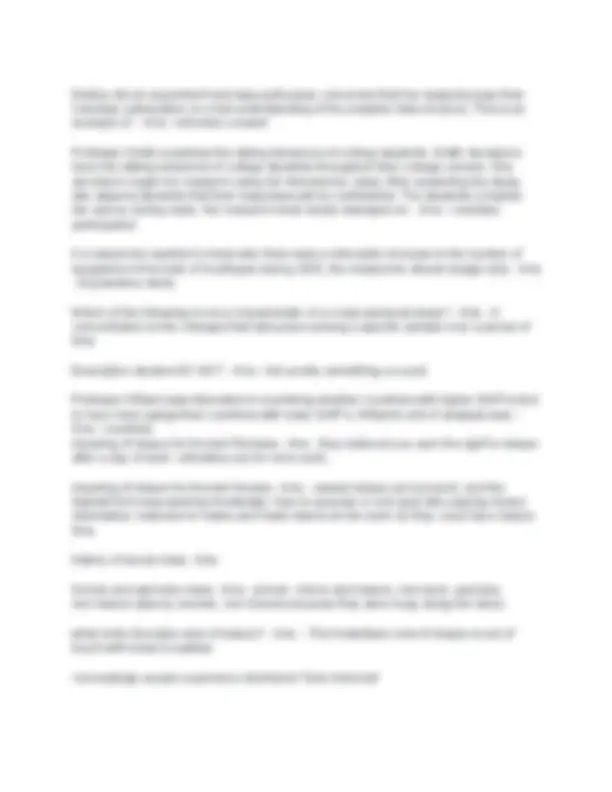
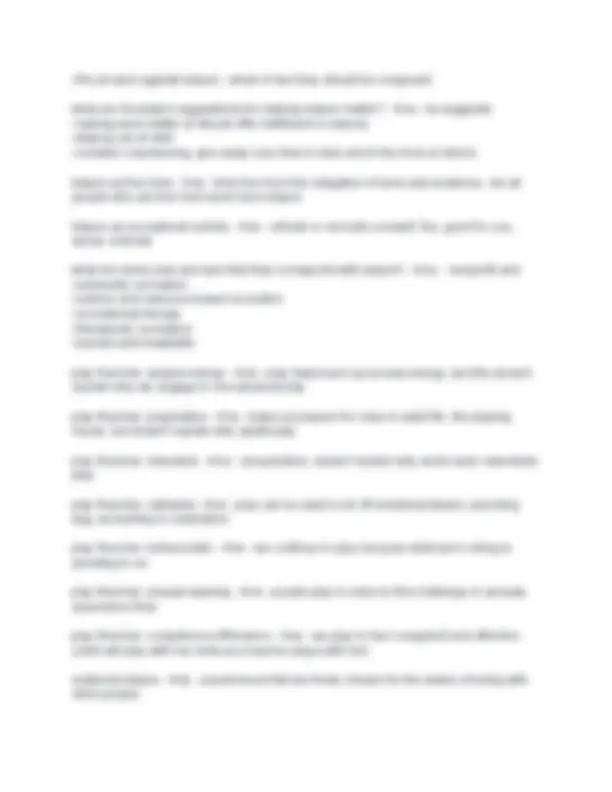
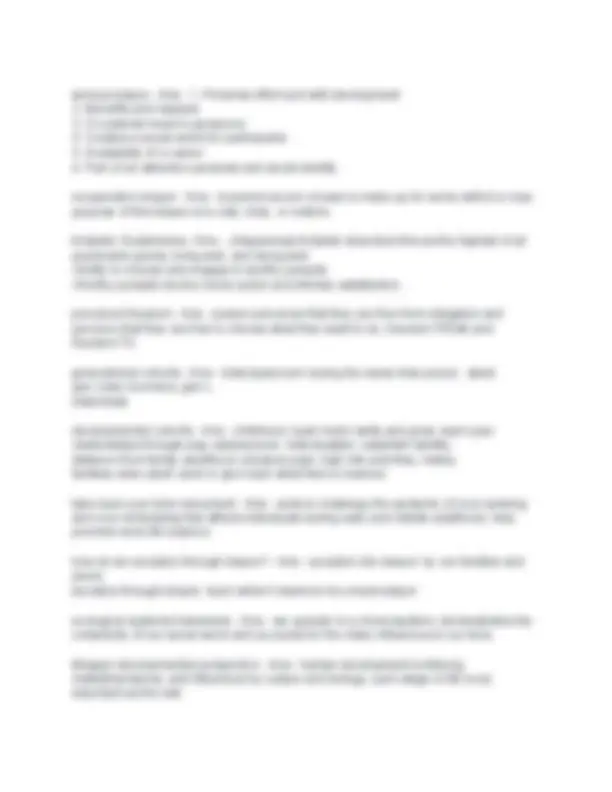
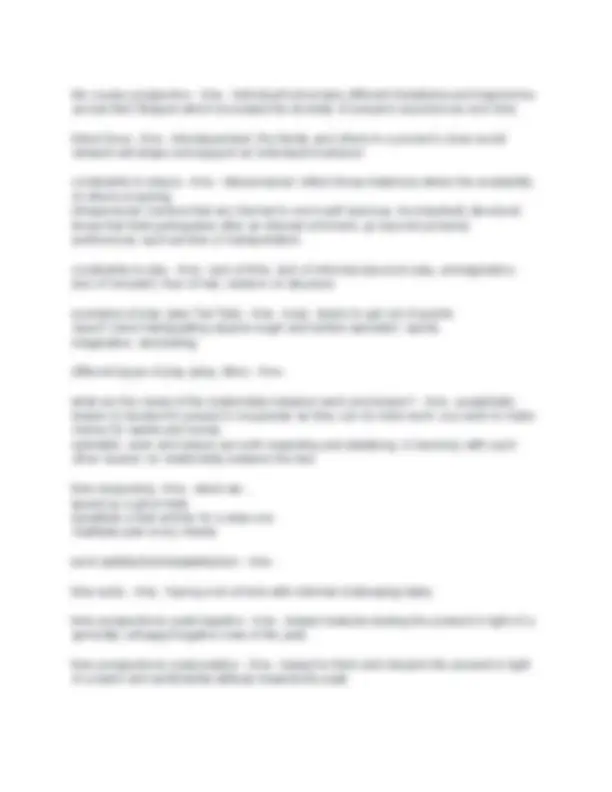
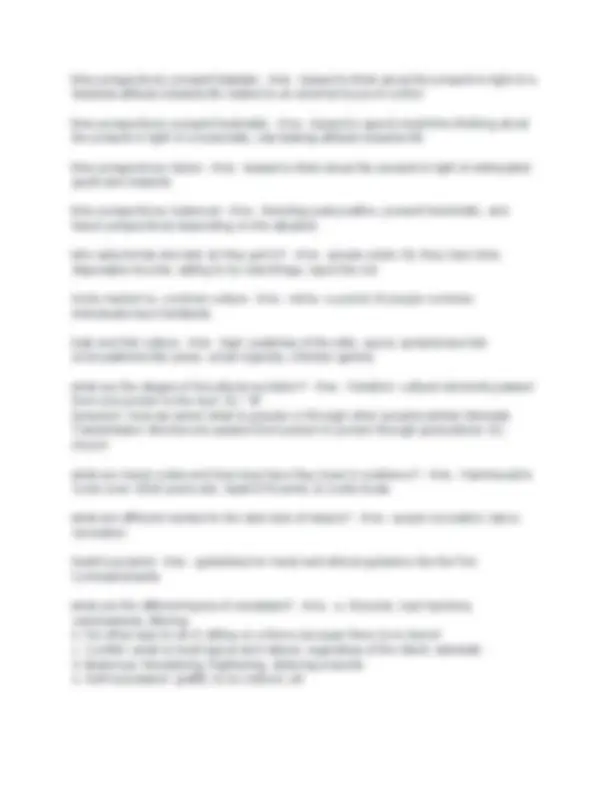
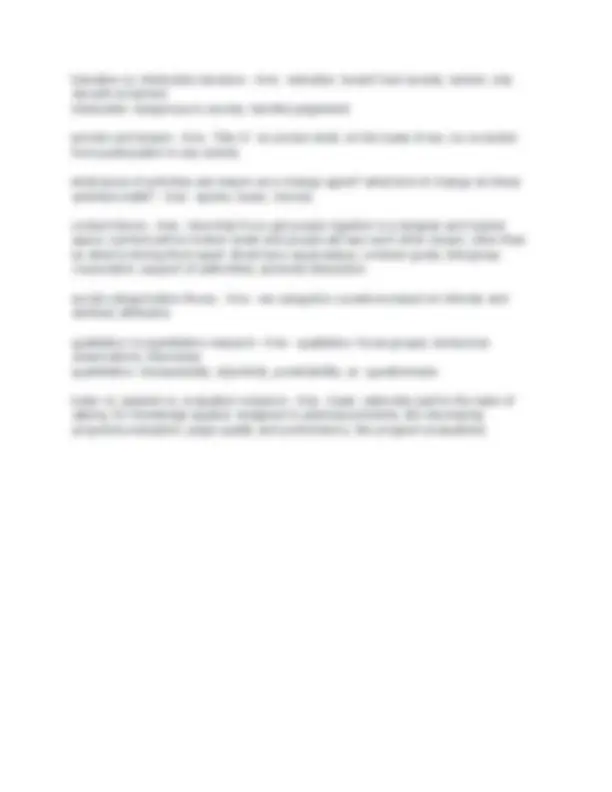


Study with the several resources on Docsity

Earn points by helping other students or get them with a premium plan


Prepare for your exams
Study with the several resources on Docsity

Earn points to download
Earn points by helping other students or get them with a premium plan
Community
Ask the community for help and clear up your study doubts
Discover the best universities in your country according to Docsity users
Free resources
Download our free guides on studying techniques, anxiety management strategies, and thesis advice from Docsity tutors
Margot wants to examine how student nurses change in their orientation towards patients over the course of their three years in nursing school. She is particularly concerned with the following changes within the same individuals. It would be best to use: A. Trend study B. Cohort study C. Panel study D. Cross-sectional study Correct Answer: C. Panel study Rationale: A panel study tracks the same individuals over time, which suits Margot’s focus on within-individual changes. A researcher must decide on the process of operationalization: A. The use of single or multiple indicators B. What level of measurement to use C. The necessary degree of precision and range of variation D. All of the above Correct Answer: D. All of the above Rationale: Operationalization includes multiple considerations such as indicators, measurement level, and precision.
Typology: Exams
1 / 27

This page cannot be seen from the preview
Don't miss anything!




















Margot wants to examine how student nurses change in their orientation towards patients over the course of their three years in nursing school. She is particularly concerned with the following changes within the same individuals. It would be best to use: A. Trend study B. Cohort study C. Panel study D. Cross-sectional study Correct Answer: C. Panel study Rationale: A panel study tracks the same individuals over time, which suits Margot’s focus on within-individual changes. A researcher must decide on the process of operationalization: A. The use of single or multiple indicators B. What level of measurement to use C. The necessary degree of precision and range of variation D. All of the above Correct Answer: D. All of the above Rationale: Operationalization includes multiple considerations such as indicators, measurement level, and precision. What is the lowest level of measurement in which there is an exact difference between attribute values? A. Nominal B. Ordinal C. Interval D. Ratio Correct Answer: C. Interval Rationale: Interval measurement identifies equal differences between values but lacks a true zero. Professor Tilton measured the variable "feelings toward drafting women" with the categories strongly agree, agree, indifferent, disagree, and strongly disagree. Professor Tilton was using the level of measurement: A. Nominal B. Ordinal
C. Interval D. Ratio Correct Answer: B. Ordinal Rationale: Ordinal scales reflect ranked order without assuming equal intervals between categories. Ignatious wanted to be sure he covered the full range of meanings in his measurement of happiness among college students. Given this, he was particularly concerned with: A. Criterion validity B. Construct validity C. Content validity D. Face validity Correct Answer: C. Content validity Rationale: Content validity ensures the full scope of the concept is captured. Marlinda developed three aspects for her concept love: communication, trust, and attraction. These aspects are known as: A. Indicators B. Variables C. Dimensions D. Attributes Correct Answer: C. Dimensions Rationale: Dimensions are components of a concept that together define it. When you are worried about whether you will get the same results if you repeat your experiment again in the future, you are worried about: A. Validity B. Generalizability C. Reliability D. Accuracy Correct Answer: C. Reliability Rationale: Reliability refers to consistency of results across repetitions. When you are worried about whether you are actually measuring what you think you are measuring, you are worried about: A. Reliability B. Internal validity C. Replicability D. Sampling error Correct Answer: B. Internal validity Rationale: Internal validity reflects the accuracy of a measure in capturing the intended concept. A weighing scale that consistently tells Susie that she is 115 pounds --- 5 pounds lighter than she really is--- every time she stands on the scale is ____, but not
Scales take into consideration the intensity with which different items reflect the variable being measured. A. True B. False Correct Answer: A. True Rationale: This distinguishes scales from simple indexes. If two items in an index are perfectly correlated, both of them should be eliminated from the index. A. True B. False Correct Answer: B. False Rationale: Redundancy might be addressed, but not necessarily by removing both items. Conceptualization is the development of research procedures that will result in empirical observations representing those concepts in the real world. A. True B. False Correct Answer: B. False Rationale: That describes operationalization. Conceptualization refers to defining concepts. If a measure is reliable, it must also be valid. A. True B. False Correct Answer: B. False Rationale: A measure can be reliable but not valid if it consistently measures the wrong thing. Precise measurement is more important than accurate measurement. A. True B. False Correct Answer: B. False Rationale: Accuracy is typically more critical to scientific validity. Precision and accuracy are synonyms. A. True B. False Correct Answer: B. False Rationale: Precision refers to consistency; accuracy refers to correctness. It is not necessary for variables to be exhaustive and mutually exclusive as long as they are well defined. A. True B. False Correct Answer: B. False
Rationale: Variables must cover all possible cases (exhaustive) and not overlap (mutually exclusive). If an exception is found to a social pattern, the pattern is invalid. A. True B. False Correct Answer: B. False Rationale: Social patterns allow for exceptions. Deductive reasoning refers to movement from a set of specific observations to the discovery of a pattern. A. True B. False Correct Answer: B. False Rationale: That describes inductive reasoning. Deduction goes from theory to observation. Social theory focuses on "how things should be." A. True B. False Correct Answer: B. False Rationale: Social theory seeks to explain how things are, not prescribe how they should be. The ethical issues are readily apparent in research projects. A. True B. False Correct Answer: B. False Rationale: Ethical issues often require deep reflection and are not always obvious. At the conclusion of his research project, Fred interviews his research subjects to discover whether they have problems because of their participation in the research project. Fred is engaged in the debriefing process. A. True B. False Correct Answer: A. True Rationale: Debriefing is a post-study ethical practice to ensure participant well-being. If two variables are correlated with each other, there must be a causal relationship. A. True B. False Correct Answer: B. False Rationale: Correlation does not imply causation. Operationalization is the process of clarifying what is meant by the concepts being used in a study. A. True
A. True B. False Correct Answer: A. True Rationale: In qualitative research, data collection and theory development often occur simultaneously. Qualitative research is undertaken for descriptive purposes, never for explanatory purposes. A. True B. False Correct Answer: B. False Rationale: Qualitative research can be used for both descriptive and explanatory purposes. Variable-oriented research is similar to the nomothetic model of explanation. A. True B. False Correct Answer: A. True Rationale: The nomothetic model seeks general laws, similar to what variable-oriented research aims for. The utility of case-oriented analysis is the fact that one case can make a theory. A. True B. False Correct Answer: B. False Rationale: A single case may illustrate a theory, but it is not sufficient for generalization. Conversational analysts look only at the structure of communication. A. True B. False Correct Answer: B. False Rationale: They consider both structure and content within context. Qualitative data processing is both a science and an art. A. True B. False Correct Answer: A. True Rationale: It involves systematic procedures and subjective interpretation. Open coding refers to the initial classification and labeling of concepts. A. True B. False Correct Answer: A. True Rationale: Open coding is the first step in grounded theory analysis. Concept mapping is appropriate for both qualitative and quantitative analysis. A. True B. False
Correct Answer: A. True Rationale: It helps visualize relationships in both research paradigms. The search for the intentional or unintentional meanings attached to signs is called semiotics. A. True B. False Correct Answer: A. True Rationale: Semiotics studies signs and the meanings they carry. The concept is the organizing principle for qualitative coding. A. True B. False Correct Answer: A. True Rationale: Concepts are central to how qualitative data is categorized and interpreted. Qualitative analysis requires the conversion of social research data into a numerical format. A. True B. False Correct Answer: B. False Rationale: Qualitative data is typically textual, visual, or verbal—not numeric. Judging the quality of qualitative research is easier than judging the quality of quantitative research. A. True B. False Correct Answer: B. False Rationale: Qualitative research has more subjective evaluation criteria, making assessment complex. Case-oriented analysis is more valuable in qualitative research than variable- oriented research. A. True B. False Correct Answer: B. False Rationale: Both approaches are valuable, depending on the research goals. It is nearly impossible to use any statistical analysis if you have collected qualitative data. A. True B. False Correct Answer: B. False Rationale: Some qualitative data can be quantified and analyzed statistically. Memoing provides the researchers with structured ways to examine the data and the coded text. A. True
Code notes... A. Track participant names B. Contain interview questions C. Identify the code labels and their meanings D. Present final conclusions Correct Answer: C. Identify the code labels and their meanings Rationale: Code notes define and explain the meaning of coding labels. Which of these concept mapping statements are TRUE? A. Concept mapping is only for surveys B. Concept mapping can be used for either quantitative or qualitative analysis C. Concept mapping has no value in theory development D. Concept mapping is outdated Correct Answer: B. Concept mapping can be used for either quantitative or qualitative analysis Rationale: It is a flexible tool useful in both research types. Which of the following is NOT a sign system used in semiotic analysis? A. Language B. Music C. Mathematics D. All of these are sign systems Correct Answer: D. All of these are sign systems Rationale: Each of these is analyzed in semiotic research. In reading court decisions, Professor Wofford notices decisions typically discuss the "rational male." Wofford begins to write notes in which she ruminates about the notion of the rational male as well as why the concept of the rational female is not mentioned. Wofford’s memos are... A. Methodological notes B. Theoretical notes C. Code notes D. Sampling notes Correct Answer: B. Theoretical notes Rationale: These memos explore theoretical implications and emerging patterns. Qualitative researchers DO NOT use the computer to... A. Record and store data B. Search for text C. Analyze coded data D. They use the computer to do all of this Correct Answer: D. They use the computer to do all of this Rationale: Computers assist with all of these tasks in qualitative research. Which of the following is NOT a fundamental assumption of conversational analysis?
A. Talk is structurally organized B. Talk is contextually organized C. The same utterance should have the same meaning in different contexts D. Conversations are socially organized Correct Answer: C. The same utterance should have the same meaning in different contexts Rationale: Meaning changes with context, contradicting this statement. Qualitative research methods involve a continuing interplay between... A. Hypotheses and theories B. Data collection and theory C. Interviews and surveys D. Statistics and interpretation Correct Answer: B. Data collection and theory Rationale: Theory often evolves during data collection in qualitative research. The primary goal in qualitative research is... A. Prediction B. Explanation C. Measurement D. Hypothesis testing Correct Answer: B. Explanation Rationale: Qualitative research aims to provide rich, contextual understanding. Alicianna examined the levels of competition among high school students. Which way of looking for patterns does this example reflect? A. Structures B. Processes C. Magnitudes D. Causes Correct Answer: C. Magnitudes Rationale: Magnitudes involve levels or amounts, such as intensity of competition. After completing a case-oriented analysis, which additional strategy will enhance theoretical understanding? A. Index construction B. Cross-case analysis C. Variable elimination D. Survey distribution Correct Answer: B. Cross-case analysis Rationale: Cross-case analysis finds patterns and supports theory development. Which type of notes identify the code labels and their meanings? A. Theoretical notes B. Method notes C. Code notes
B. It compares incidents applicable to each category C. It avoids theory building D. It delimits theory development Correct Answer: C. It avoids theory building Rationale: The constant comparative method is specifically designed to support theory building in grounded theory research. Theoretical notes are used to: A. Record participant names B. Track data entry progress C. Capture the researcher’s reflections on the meaning of concepts and theoretical relationships D. List interview questions Correct Answer: C. Capture the researcher’s reflections on the meaning of concepts and theoretical relationships Rationale: Theoretical notes (or memos) help document and develop the researcher’s evolving ideas and conceptual insights. Which of the following is NOT an assumption of conversation analysis? A. Talk is structurally organized B. Talk is contextually organized C. Conversations have no meaningful patterns D. Participants orient to talk in a meaningful way Correct Answer: C. Conversations have no meaningful patterns Rationale: Conversation analysis is founded on the assumption that conversations do have meaningful patterns. Concept mapping allows researchers to: A. Automatically generate statistical tests B. Visually represent relationships between concepts C. Replace the need for coding D. Avoid using software Correct Answer: B. Visually represent relationships between concepts Rationale: Concept mapping is a tool used to display and think through connections among various ideas or themes. Which of the following is TRUE regarding open coding? A. It is the last phase of grounded theory B. It involves selectively coding only major themes C. It involves breaking down, examining, comparing, and categorizing data D. It focuses on hypothesis testing Correct Answer: C. It involves breaking down, examining, comparing, and categorizing data Rationale: Open coding is an early analytic process where data are dissected and conceptual labels are applied.
What is a common advantage of using software in qualitative data analysis? A. It removes the need for interpretation B. It can replace theoretical thinking C. It helps manage, organize, and retrieve coded data D. It automatically writes the research report Correct Answer: C. It helps manage, organize, and retrieve coded data Rationale: Software does not analyze for you but supports the organization and retrieval of data for interpretation. Which type of qualitative analysis emphasizes the interpretation of symbols and meanings? A. Grounded theory B. Semiotic analysis C. Content analysis D. Statistical regression Correct Answer: B. Semiotic analysis Rationale: Semiotics is focused on signs, symbols, and the meanings they convey within cultural contexts. In qualitative research, memoing is used to: A. Record budget information B. Create survey instruments C. Capture analytical thoughts during the coding process D. Standardize responses Correct Answer: C. Capture analytical thoughts during the coding process Rationale: Memos document reflections, patterns, and analytical insights throughout the research process. Which of the following is NOT typically a focus of qualitative research? A. Context B. Meaning C. Generalization to large populations D. Process Correct Answer: C. Generalization to large populations Rationale: Unlike quantitative research, qualitative research does not aim for broad generalization. Which best describes axial coding in grounded theory? A. Initial labeling of data B. Drawing final conclusions C. Identifying relationships between categories and subcategories D. Statistical testing of hypotheses Correct Answer: C. Identifying relationships between categories and subcategories Rationale: Axial coding refines and connects concepts developed during open coding
Which of the following identifies the code labels and their meanings? - Ans - Code notes Which of the following is NOT one of the questions to ask when assessing the quality of qualitative research? - Ans - Are the results generalizable to other populations? The unit about which information is collected and that provides the basis of analysis is called - Ans - Element Every kth element in a list is chosen for inclusion in the sample in - Ans - systematic sampling A disadvantage of stratified sampling is that it - Ans - requires you to have some prior knowledge about the elements in the population before drawing the sample You want to select a sample of 3,000 people from a population of 300,000. to use the table of random numbers you need to work with a - Ans - 6 - digit number Jerome is worried about the periodicity in his sampling frame. Jerome should not use - Ans - systematic sampling Stratification is based on which principle? - Ans - a homogeneous population produces samples with smaller errors Andre surveyed the first ten students walking out of the library on three consecutive evenings, starting at 7PM. Which sampling design does this example reflect? - Ans - Reliance on available subjects When people selected for a sample are not typical or representative of the larger population from which they have been selected, we have a - Ans - bias or unrepresentative sample A table of random numbers is used for which design? - Ans - simple random sampling What is the basic process in probability proportionate to size sampling? - Ans - give bigger clusters a greater chance of being picked but then take the same number of elements per cluster A friend of yours, a senior, took the Graduate Record Exam in September and scored in the 99th percentile. In February, your friend took the same exam over again. This time your friend scored in the 84th percentile. As a research methods student, you told your friend that his/her lowered score was most likely due to - Ans - statistical selection
The chief purpose of probability sampling is to be able to select - Ans - a sample whose statistics will accurately portray an unknown population parameter You are doing research on hospital personnel--orderlies, technicians, nurses and doctors. You want to be sure you draw a sample that has cases in each of the personnel categories. You want to use probability sampling. An appropriate strategy would be - Ans - stratified sampling A summary description of a variable in a sample is called a - Ans - statistic Among the requirements for the classical experimental design is a posttest measurement of the - Ans - dependent variable for both the experimental and control groups The double-blind experiment is one which which - Ans - neither the subjects in the experimental or control groups nor the experimenters know which are the experimental or control group. The Solomon four-group design - Ans - combines the classical experimental design with the posttest-only control group design To ensure that all your participants have an equal opportunity to be in either experimental group (one receives a drug, the other group receives a placebo), you decide to toss a coin to determine who gets placed in which group. You have engaged in ________. - Ans - Random assignment The experimental and control groups should be comparable on - Ans - variables that are likely to be related to the dependent variable under study The primary function of the probe is to - Ans - get the respondent to answer a question more fully A key problem associated with secondary analysis is - Ans - Validity Which of the following is NOT recommended for conducting online surveys - Ans - keep changing terminology to keep respondents interested According to Babbie, the minimum level for an adequate response rate for analysis and reporting is - Ans - 50 percent Which question construction guideline does the following questionnaire item most clearly violate? "Would you not say that crime is not a serious problem in the U.S.?" - Ans - avoid negative items
Fantanella did a content analysis of letters to the editor. She counted the number of times that the words "disagree" and "agree" appeared, but she also coded the underlying message of the letters as being positive or negative. Counting the number of times the two words appeared is known as coding the - Ans - manifest content A study population is - Ans - that aggregation of elements from which the sample is actually selected In a sample stratified by gender, the sampling error on this variable is reduced to zero. - Ans - TRUE The size of the population must be taken into account when deciding on sample size. - Ans - FALSE In research, the statistic is more accurate than the parameter. - Ans - FALSE In a natural experiment, the researcher does NOT manipulate the independent variable.
Focus group participants are typically selected via probability samples. - Ans - FALSE Qualitative field researchers should wait to record observations until enough time has passed to put the events in a proper perspective. - Ans - FALSE Logical reasoning and replication are used to handle the problem of validity in the analysis of existing statistics - Ans - TRUE Since content analysis is unobtrusive, the very nature of observing the data will not have any effect on the data. - Ans - TRUE The primary ethical concern with unobtrusive research is the issue of accuracy - Ans - FALSE Content analysis is a method of data collection in which some form of communication is studied systematically - Ans - TRUE Existing statistics should be used as supplemental data only. - Ans - FALSE Standard probability sampling technique should NOT be used in content analysis. - Ans